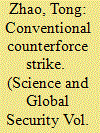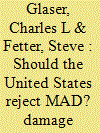| Srl | Item |
| 1 |
ID:
108152


|
|
|
|
|
| Publication |
2011.
|
| Summary/Abstract |
China and some other nuclear-armed countries have become concerned about the development and deployment of U.S. conventional global strike systems that may permit damage limitation operations against the nuclear forces of adversaries. This article argues that a counterforce strike is more likely to target tactical nuclear forces than intercontinental ballistic missiles and provides an analysis of the probability that U.S. conventional strikes might destroy China's theater nuclear forces which include DF-3A, DF-4, DF-21, DF-31 missiles, Type 094 nuclear submarines, and nuclear-capable H-6 bombers. The results indicate that China's strategy of building robust underground facilities may effectively protect its nuclear forces from preemptive strikes making it unlikely that a U.S. conventional strike could destroy a meaningful part of China's theater nuclear forces. This study also assesses the potential capabilities of future conventional prompt global strike systems, points out problems with the strategy of damage limitation, and proposes that the United States consider improving strategic stability in its relationship with China rather than threatening a preemptive strike.
|
|
|
|
|
|
|
|
|
|
|
|
|
|
|
|
| 2 |
ID:
147046


|
|
|
|
|
| Summary/Abstract |
As China invests in its nuclear forces and U.S.-China relations become increasingly strained, questions of U.S. nuclear doctrine require greater attention. The key strategic nuclear question facing the United States is whether to attempt to maintain and enhance its damage-limitation capability against China. The answer is less straightforward than it was during the Cold War, because China's nuclear force is orders of magnitude smaller than the Soviet force was. Part of the answer depends on the military-technical feasibility of the United States achieving a significant damage-limitation capability: What would be the outcome of military competition over the survivability of China's intercontinental ballistic missiles, submarine-launched ballistic missiles, and command and control, and over the effectiveness of U.S. ballistic missile defenses? The answer also depends on the benefits that a damage-limitation capability would provide; these could include contributions to homeland deterrence, extended deterrence, and reassurance of U.S. regional allies. The final piece of the analysis concerns the potential costs of a damage-limitation capability, which could include increased escalatory pressures during crises and growing political tension between the United States and China. A thorough analysis demonstrates that the United States should forgo such a capability because the prospects for preserving a significant damage-limitation capability are poor; the deterrent benefits would be small; and the escalatory and political costs would be relatively large.
|
|
|
|
|
|
|
|
|
|
|
|
|
|
|
|